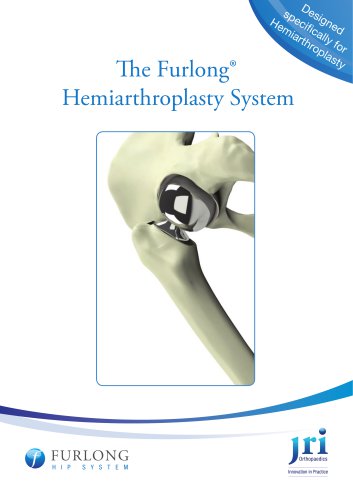 Website:
JRI Orthopaedics
Website:
JRI Orthopaedics
Catalog excerpts

Keeping up to date with the latest innovations.
Open the catalog to page 1
VAIOS® – Innovation in Practice Shoulder replacement has provided good clinical outcomes over the past 15 years. However, a number of challenges have been identified that can compromise the long term success of shoulder arthroplasty often requiring early revision of the prosthesis. To overcome these well documented failure modes (see opposite) experts in the field of shoulder replacement surgery, biomechanical engineering, joint replacement design and manufacturing collaborated to develop a shoulder replacement system that is Versatile, Anatomic, Inverse Optimised and Stable (VAIOS®) whilst...
Open the catalog to page 2
Why do Current Designs Fail in Shoulder Arthroplasty? Why do current designs fail?1 Loose Glenoid Loose Humeral Norwegian Arthroplasty Register 1994 - 2006 VAIOS® has been designed to address the failure modes which account for 64% of early shoulder revisions PROBLEM Glenoid loosening requiring early revision Shoulder dislocation and instability Loose humeral component 4 screws for secure fixation Superior and inferior locking screws Curved back to improve load distribution Limited radial mismatch to preserve polyethylene (poly) • Supravit® H-A.C. coated to maximise secondary fixation • 4...
Open the catalog to page 3
Versatility VAIOS® is designed to offer maximum versatility, allowing the surgeon to adapt intraoperatively to meet the patient’s clinical needs, whilst minimising the components and instruments required. Complete Shoulder Replacement System • Modular humeral component reduces prothesis inventory but allows for either uncemented or cemented distal stem options • Humeral neck design with wiring holes facilitates treatment of proximal humeral fractures • Unique design allows for an easy exchange from anatomic to inverse shoulder arthroplasty without the need to replace the Glenoid metal-back...
Open the catalog to page 4
Versatility Glenoid metal-back Designed to be used in anatomic and inverse shoulder arthroplasty ensuring maximum intraoperative flexibility with minimum inventory. • Curved Mounting Surface – Converts micromotion-inducing shear forces to compression forces at the implant / bone interface, encouraging bone ingrowth into the H-A.C. coating • Supravit® Zoned H-A.C. coating – “clinically proven coating provides high shear strength, designed to increase longevity”2 • Large Glenoid peg – provides central support to recruit cortical bone • Tapered Peg profile – generates compressive force at the...
Open the catalog to page 5
Optimisation Scapular Notching – Studies report 74% Notching rate3 Development of notches can be the result of high contact stresses or bone loss from the contact of the prosthesis with the scapula Scapular Notching - Delta III Overcoming the weaknesses of current Inverse Arthroplasty designs:4 • Extensive biomechanical modelling at Newcastle University has identified the optimal offset of centre of rotation from the humeral shaft to reduce subacromial impingement of the humerus • The Newcastle Shoulder Model has identified the optimal cup depth to ensure the stability of the prosthesis is...
Open the catalog to page 6
Optimisation Total Shoulder Arthroplasty – Inverse • 42mm head diameter – increases the moment arm of the deltoid muscle – increases joint stability – increases the inferior Glenoid clearance • Removal of material in non-articulating region of the head – simplifies implantation of the definitive prosthesis and minimises risk of over stuffing the joint • 150˚ Equivalent Neck Shaft Angle – provides optimal balance between impingement and stability • Optimal cup depth – has been shown by the Newcastle Shoulder Model as being the most effective way of reducing inferior impingement without...
Open the catalog to page 7
Full Modularity Common Humeral and Glenoid components, combined with the modularity of the VAIOS® system, offers the surgeon complete intraoperative flexibility to perform Anatomic, Inverse, Trauma and Revision shoulder arthroplasty with only three instrument trays. Glenoid Metal Back H-A.C. Supravit® Zoned Coated Titanium Glenoid Insert UHMWPE 2 Glenoid Coverage Sizes Conforming or 4 mm Radial Mismatch for each head size Glenoid Cemented 2 Glenoid Coverage Sizes Conforming or 4 mm radial mismatch for each head size Glenoid Screw Cap Integral Introducing Handle Humeral Head Polished (CoCr)...
Open the catalog to page 8
Cortical Bone Screw ±15º Adjustable Superior/ Inferior Locking Screws Glenoid Dome Polished Cobalt Chrome (CoCr) Inverse Humeral Insert Ultra High Molecular Weight Polyethylene (UHMWPE) Locking Screw Humeral Metal Back Titanium Humeral Stem H-A.C. H-A.C. Supravit® Coated Titanium 8, 10 and 12, 14 and 16 mm Diameters
Open the catalog to page 9
Maximum Versatility Minimum Inventory Maximum versatility Single instrument set for anatomic, inverse, trauma and revision shoulder arthroplasty. Minimum inventory Minimum components - reduced complexity without compromising clinical choice.
Open the catalog to page 10
Case Studies VAIOS® Inverse TSA Female; Aged 64 Systemic Lupus Erythematosus Stiff painful Right shoulder At surgery supraspinatus very fibrotic and tight. Initially shoulder prepared for an Anatomical TSA with insertion of the Glenoid baseplate and humeral stem and neck. The supraspinatus was then found to be avulsed and the Anatomical was changed to an Inverse before completion of the operation. Very tight arthritic right shoulder Pre-Op x-ray on 05 Jan 2010 Right shoulder VAIOS® Inverse TSA - 09 Jun 2010 Post-Op x-ray on 10 Jun 2010
Open the catalog to page 11
Case Studies VAIOS® Inverse TSA Female; Aged 56 Massive Rotator Cuff Tear (5x6cm) Left shoulder. Previous Right Massive Rotator Cuff Tear successfully repaired in 2008. Repair attempted at operation but not possible. Operation converted to a VAIOS® Inverse TSA on the table. This patient had bilateral massive Rotator Cuff Tears. The right shoulder (shown) was successfully treated with a RC repair operation in 2008. The left shoulder was similar but x-rays are not available. The x-rays of the right shoulder represent similar pre-operative appearances to those of the left shoulder. Massive RC...
Open the catalog to page 12All JRI Orthopaedics catalogs and technical brochures
-
Bone Substitute Portfolio
8 Pages
-
furlong-securus
28 Pages
-
Furlong
20 Pages





